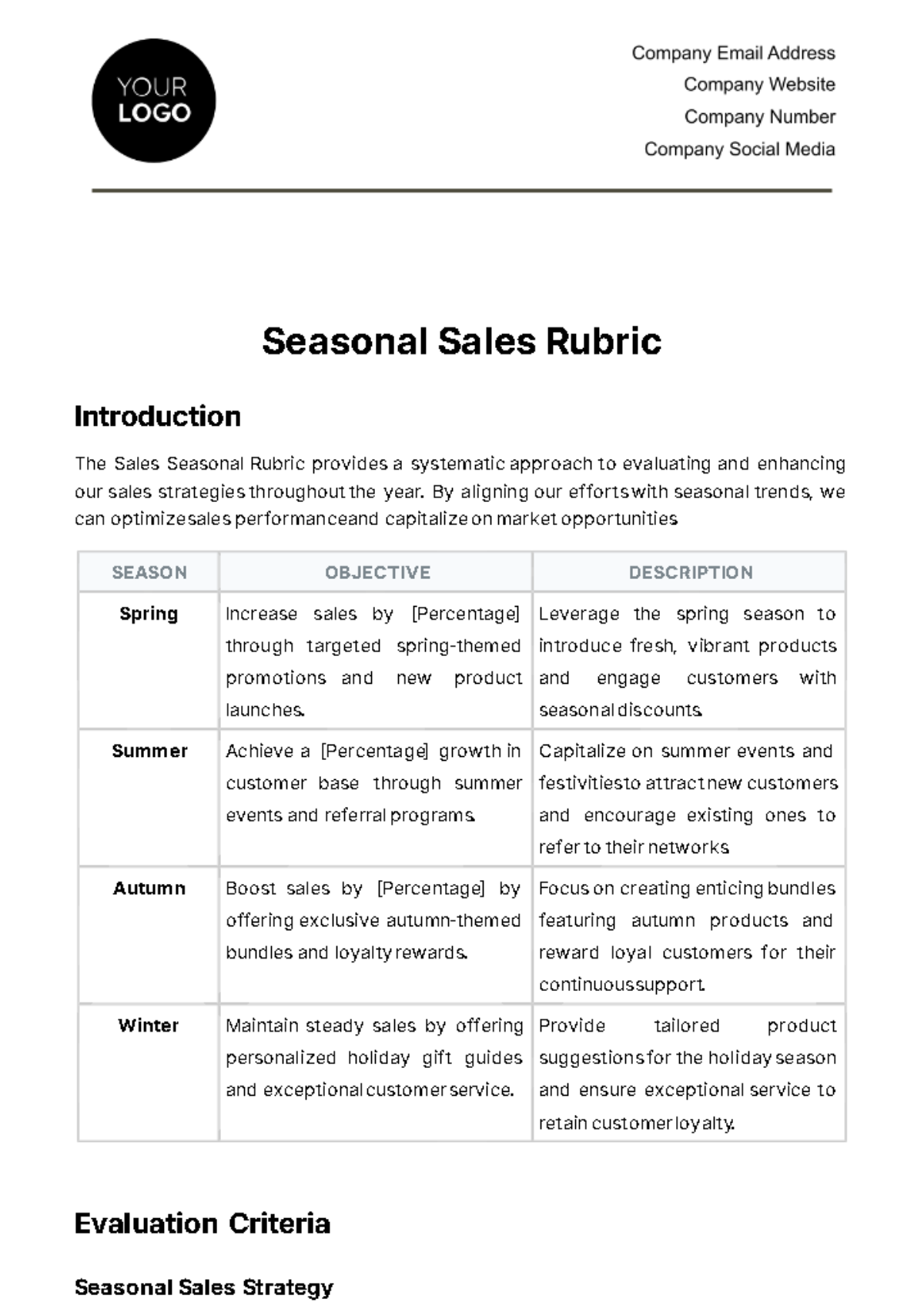Seasonal Sales Rubric
Introduction
The Sales Seasonal Rubric provides a systematic approach to evaluating and enhancing our sales strategies throughout the year. By aligning our efforts with seasonal trends, we can optimize sales performance and capitalize on market opportunities.
SEASON | OBJECTIVE | DESCRIPTION |
|---|
Spring | Increase sales by [Percentage] through targeted spring-themed promotions and new product launches. | Leverage the spring season to introduce fresh, vibrant products and engage customers with seasonal discounts. |
Summer | Achieve a [Percentage] growth in customer base through summer events and referral programs. | Capitalize on summer events and festivities to attract new customers and encourage existing ones to refer to their networks. |
Autumn | Boost sales by [Percentage] by offering exclusive autumn-themed bundles and loyalty rewards. | Focus on creating enticing bundles featuring autumn products and reward loyal customers for their continuous support. |
Winter | Maintain steady sales by offering personalized holiday gift guides and exceptional customer service. | Provide tailored product suggestions for the holiday season and ensure exceptional service to retain customer loyalty. |
Evaluation Criteria
Seasonal Sales Strategy
Evaluation Criteria: Alignment with seasonal objectives, promotion creativity, and effectiveness in driving sales.
Description: Assessing how well our sales strategies align with the specific goals and creativity in capitalizing on seasonal themes.
Adaptability
Evaluation Criteria: Responsiveness to market shifts, agility in adjusting strategies, innovation in adapting to changing customer demands.
Description: Evaluating the ability to swiftly adapt strategies in response to changing market dynamics and customer preferences.
Customer Engagement
Evaluation Criteria: Engagement levels during seasonal events, feedback responsiveness, and customer participation in promotions.
Description: Evaluating the depth and effectiveness of customer engagement strategies during each season.
Market Trends
Evaluation Criteria: Monitoring of market trends, incorporation of trending products, and proactive response to industry shifts.
Description: Assessing our ability to identify and respond proactively to emerging market trends and incorporate them into our offerings.
Seasonal Assessment
Spring Assessment
Our spring sales strategy scored [Number] out of [Number]. Customers responded positively to our new product launches, but there is room for improvement in event engagement.
Summer Assessment
Achieved a [Number] out of [Number]. The referral program was highly successful, but customer retention after events needs enhancement.
Autumn Assessment
Scored [Number] out of [Number]. Bundles were well-received, but loyalty rewards could be optimized for higher engagement.
Winter Assessment
Earned [Number] out of [Number]. Personalized gift guides were a hit, and customer service received excellent feedback.
Recommendations
Based on the assessment, here are our recommendations:
Spring: Enhance event engagement through interactive activities and live demonstrations.
Summer: Strengthen post-event follow-ups to improve customer retention rates.
Autumn: Review the loyalty reward structure to make it more appealing.
Winter: Continue the personalized approach and consider extending loyalty rewards during the holiday season.
Conclusion
The Sales Seasonal Rubric is an essential tool for refining our sales strategies. Through continuous assessment and adaptability, we can ensure that our sales efforts align with market dynamics and customer expectations, maximizing our revenue potential.
For any inquiries or additional information, please contact [Your Name] at [Your Company Email].
Sales Templates @ Template.net




























